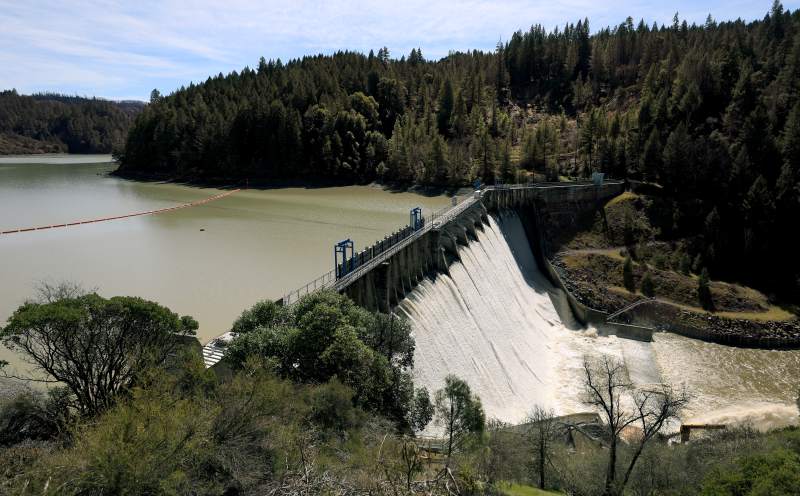
GUY KOVNER
THE PRESS DEMOCRAT May 13, 2020
A nearly century-old dam on Eel River that impounds Lake Pillsbury is slated for removal under a $500 million proposal submitted Wednesday by Sonoma County and four other regional partners seeking to take over from PG&E a remote hydropower project in Mendocino County.
The county and its partners, including Mendocino and Humboldt counties, hailed the proposal as a milestone in their effort to meet the needs of all three counties, protecting farmers, fish and communities and maintaining a key source of water for the Russian River system that serves 600,000 customers in Sonoma and Marin counties.
The dam removal alone, a long-sought goal of environmental groups, would be the highest-profile project to improve habitat for imperiled North Coast salmon and steelhead in decades, perhaps behind only the dam removal planned on the Klamath River.
But the filing is just the first step in a complex process that involves establishing a new operator for a historic powerhouse in Potter Valley that PG&E surrendered a year ago because its meager generating capacity was no longer economical, the utility said.
That hydropower project also funnels Eel River water into the Russian River basin, bolstering supplies for cities and grape growers along the Russian’s northern reaches.
Grant Davis, the general manager of Sonoma Water, the region’s dominant supplier of drinking water for residents, called the feasibility study filed with the Federal Energy Regulatory Commission “a pathway forward that will achieve a more reliable water supply for the region while protecting and restoring two remarkable rivers.”
Rep. Jared Huffman, D-San Rafael, said in a statement the proposal was a “significant step toward a win-win outcome for the North Coast and North Bay: robust restoration of Eel River fisheries and longterm certainty and reliability for Russian River water users.”
Initial studies have indicated capital costs for project facilities from $100 million to $400 million with an additional $30 million to $120 million for new equipment that would provide sufficient water for Potter Valley, an 7,000-acre farming region in Mendocino County that has prospered due to water delivered by the project.
Annual operating costs would be in the $5 million to $10 million range.
Davis acknowledged the formidable cost, saying both the amount and who pays it remain to be determined.
“There are a great deal of unknowns,” he said.
Part of the work to be done involves “monetizing the water supply and the energy,” Davis said.
The 138-foot Scott Dam was built in 1922, impounding behind it Lake Pillsbury in Lake County. Its removal would clear the way to historic spawning grounds in the upper Eel for protected salmon and steelhead runs.
In addition to the three counties, the partnership includes California Trout, a 50-year-old environmental organization, and the Round Valley Indian Tribes.
The Potter Valley Project consists of two dams, a water diversion facility and a mile-long tunnel and series of pipes that deliver Eel River water to the Russian River basin via a powerhouse off Highway 20 about 20 miles north of Ukiah.
Now diverting more than 20 billion gallons of Eel River water a year, the project turned the otherwise arid Potter Valley into an agricultural powerhouse that produces $34 million worth of wine grapes, cattle and other products a year.
Flowing from the valley into the Lake Mendocino reservoir at Ukiah, the water continues into the Russian River, supporting agriculture worth $743 million from Redwood Valley to the Sonoma County line and the famed vineyards of the Alexander Valley near Healdsburg.
Sonoma Water, the county water agency, depends on Lake Mendocino to maintain mandated flows for federally protected fish from the lake down to Healdsburg, where Dry Creek brings in water from Lake Sonoma, the region’s largest dam.
Since PG&E surrendered its interest in renewing the federal license to operate the project in January, 2019, the partners — brought together by Huffman — have been seeking what they called a “two-basin solution” to address the needs in both the Eel and Russian river watersheds.
As the project relicensing process emerged three years ago, finding a solution to the competing claims for the diverted water seemed challenging.
Huffman said at the time it would bring change to the system that dates back to the early 1900s.
“The status quo is unlikely to continue,” he said.
This story will be updated. Check back for updates.
You can reach Staff Writer Guy Kovner at 707-521-5457 or guy.kovner@pressdemocrat.com. On Twitter @guykovner.

